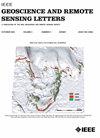一种新型去埋线-线法测量宽带土壤介电常数
IF 4
3区 地球科学
Q2 ENGINEERING, ELECTRICAL & ELECTRONIC
引用次数: 4
摘要
提出了一种新的去嵌入线-线法,用于准确测定加载到EIA 1-5/8”同轴传输线测量系统中的土壤样品的复相对介电常数。该方法有三个主要特点。首先,它只使用两根长度不同的同轴线,从而绕过了系统的校准要求。其次,它不需要任何数值技术来确定$\ varepsilon_ {r}$。第三,它不需要了解用于支撑土样品的头的电磁特性和厚度信息。接下来,通过使用全三维电磁模拟程序(CST Microwave Studio)进行模拟和对聚乙烯(PE)材料进行$\varepsilon _{r}$测量来验证该方法。最后,测量了土耳其加济安泰普市不同地区的三种风干和水饱和土壤样品的varepsilon _{r}$值,这些样品的含沙量为90%或以上,具有不同的电导率(ec)。本文章由计算机程序翻译,如有差异,请以英文原文为准。
Broadband Soil Permittivity Measurements Using a Novel De-Embedding Line–Line Method
A new de-embedding line–line method has been proposed for accurate complex relative permittivity ( $\varepsilon _{r}$ ) determination of soil samples loaded into an EIA 1-5/8” coaxial transmission line measurement system. The method has three main features. First, it bypasses the requirement of calibration of this system by using only two identical coaxial lines with different lengths. Second, it does not need any numerical technique for $\varepsilon _{r}$ determination. Third, it does not require knowledge of electromagnetic properties and thickness information of the bead used for supporting soil samples. The method is next validated by simulations performed using a full 3-D electromagnetic simulation program (CST Microwave Studio) and by $\varepsilon _{r}$ measurement of a polyethylene (PE) material. Finally, $\varepsilon _{r}$ values of three air-dried and water-saturated soil samples having 90% or more sand content with different electrical conductivities (ECs) and gathered from different areas of the city Gaziantep in Turkey, were measured.
求助全文
通过发布文献求助,成功后即可免费获取论文全文。
去求助
来源期刊

IEEE Geoscience and Remote Sensing Letters
工程技术-地球化学与地球物理
CiteScore
7.60
自引率
12.50%
发文量
1113
审稿时长
3.4 months
期刊介绍:
IEEE Geoscience and Remote Sensing Letters (GRSL) is a monthly publication for short papers (maximum length 5 pages) addressing new ideas and formative concepts in remote sensing as well as important new and timely results and concepts. Papers should relate to the theory, concepts and techniques of science and engineering as applied to sensing the earth, oceans, atmosphere, and space, and the processing, interpretation, and dissemination of this information. The technical content of papers must be both new and significant. Experimental data must be complete and include sufficient description of experimental apparatus, methods, and relevant experimental conditions. GRSL encourages the incorporation of "extended objects" or "multimedia" such as animations to enhance the shorter papers.
 求助内容:
求助内容: 应助结果提醒方式:
应助结果提醒方式:


